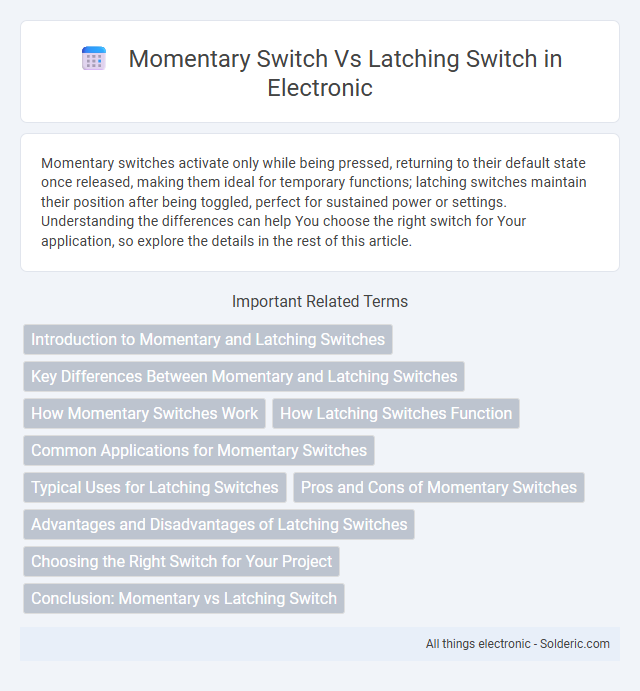Momentary switches activate only while being pressed, returning to their default state once released, making them ideal for temporary functions; latching switches maintain their position after being toggled, perfect for sustained power or settings. Understanding the differences can help You choose the right switch for Your application, so explore the details in the rest of this article.
Comparison Table
| Feature | Momentary Switch | Latching Switch |
|---|---|---|
| Definition | Switch that stays active only while pressed | Switch that maintains its state until toggled again |
| Operation | Temporary, spring-return action | Toggle or push-on/push-off action |
| Use Cases | Reset buttons, doorbells, keyboards | Light switches, power switches, mode selectors |
| Electrical State | Active only during press | Maintains ON or OFF state until switched |
| Mechanism | Spring-loaded | Mechanical or electronic latch |
| Power Consumption | Low, only during activation | Constant, depending on load |
| Typical Form Factors | Push button, dome switch | Toggle switch, rocker switch |
Introduction to Momentary and Latching Switches
Momentary switches are designed to maintain contact only while being pressed, making them ideal for applications requiring temporary activation such as doorbells and keyboards. Latching switches remain in their set position after being pressed, serving well in devices like power switches and light toggles where a stable on/off state is necessary. The key distinction lies in their operating mechanism: momentary switches return to their default position automatically, while latching switches retain their position until pressed again.
Key Differences Between Momentary and Latching Switches
Momentary switches only remain in their ON state while being pressed, automatically returning to OFF once released, ideal for applications requiring temporary activation like doorbells or keyboards. Latching switches maintain their state after being pressed, toggling between ON and OFF until pressed again, commonly used in power buttons and lighting controls. Understanding these operational differences is crucial for selecting the appropriate switch based on control needs and user interaction.
How Momentary Switches Work
Momentary switches work by completing an electrical circuit only while being pressed, instantly sending a signal to control devices or systems. When released, the switch returns to its default open or closed state, interrupting the current flow. Your choice of a momentary switch is ideal for applications requiring temporary activation, such as doorbells or keyboard keys.
How Latching Switches Function
Latching switches maintain their position after being pressed, using an internal mechanical or magnetic mechanism to stay either on or off until actuated again. This switch type allows circuits to remain powered without continuous user interaction, making them ideal for applications requiring stable on/off control. In contrast to momentary switches that return to their default state immediately after release, latching switches provide persistent connectivity, enabling device states to be preserved.
Common Applications for Momentary Switches
Momentary switches are frequently used in applications requiring temporary activation such as doorbells, computer keyboards, and automotive starters. These switches remain active only when pressed, providing precise control in devices like emergency stop buttons and gaming controllers. Your choice of a momentary switch ensures reliable performance in scenarios demanding quick, momentary engagement.
Typical Uses for Latching Switches
Latching switches are typically used in applications requiring a stable, maintained on or off state without continuous user input, such as power buttons on electronic devices, home lighting control systems, and industrial machinery controls. These switches are ideal for circuits where the switch position needs to be retained until manually changed, ensuring reliable operation in settings like security systems, automotive electronics, and remote controls. Their ability to hold the last state reduces power consumption and enhances user convenience by eliminating the need for constant pressure.
Pros and Cons of Momentary Switches
Momentary switches offer precise control by only activating when pressed, reducing power consumption and minimizing accidental operation. Their simplicity and durability make them ideal for applications requiring quick, temporary signals, yet they can be less suitable for maintaining a state without continuous user interaction. Limited feedback and the need for constant pressure can pose challenges in scenarios demanding stable, long-term switching.
Advantages and Disadvantages of Latching Switches
Latching switches maintain their state without continuous power, offering energy efficiency and reliable performance in applications like lighting controls and memory storage. However, their mechanical complexity can lead to higher wear and potential failure over time compared to momentary switches. Your choice depends on whether maintaining a switch position without constant input is crucial for your device's functionality.
Choosing the Right Switch for Your Project
Choosing the right switch for your project depends on the required control mechanism: a momentary switch activates only while pressed, ideal for short-term actions and reset functions, whereas a latching switch maintains its state until toggled again, perfect for ON/OFF applications requiring sustained operation. Momentary switches offer quick, temporary engagement, making them suitable for user inputs that need immediate responses without state retention. Your project's functionality and user interaction preferences will guide whether a momentary or latching switch best meets your design and performance needs.
Conclusion: Momentary vs Latching Switch
Momentary switches are ideal for applications requiring temporary activation, such as keyboards or doorbells, as they return to their default state once released. Latching switches maintain their position until toggled again, making them suitable for devices like power switches or mode selectors. Your choice depends on whether you need a brief or persistent electrical connection for optimal device performance.
momentary switch vs latching switch Infographic

 solderic.com
solderic.com